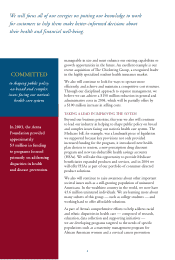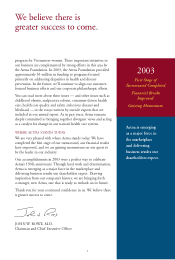Aetna 2003 Annual Report Download - page 19
Download and view the complete annual report
Please find page 19 of the 2003 Aetna annual report below. You can navigate through the pages in the report by either clicking on the pages listed below, or by using the keyword search tool below to find specific information within the annual report.
17
from being poisoned by lead
paint from deteriorating
housing or developing asthma
from nitrogen dioxide emitted
by inadequately vented stoves
and heating appliances.
With regard to children in
particular, it is necessary to
focus not solely on health
care but on health status
more broadly, adopting a
comprehensive, multifaceted
approach.
We — parents, providers,
advocates, businesses and
government — must ensure
that all children, regardless
of race or income, receive
the healthy start they, and
our future, deserve.
Access to quality care
is necessary, but
not sufficient to
eliminate children’s
health disparities.
It is unconscionable as well as economically foolish for this rich
nation, blessed with the most advanced medical technologies
in the world, to allow our poor and minority children to
carry a disproportionate burden of illness and death.
Despite the miraculous improvements in America’s health in
the last century, we shamefully enter the 21st century no closer
to narrowing the gap in children’s health.
Minority children continue to
lag behind white children in
almost every health indicator.
Disparities persist in the
rates of infant mortality,
immunization, insurance
coverage, asthma, dental care
and lead poisoning, among
other indicators. The impact
of conditions such as lead
poisoning on cognitive and
physical development can affect
children throughout their lives.
Our success in reducing health
disparities among children will
not only lessen future health
care costs, but will also increase
the nation’s productivity.
Leading employers are
recognizing that developing
strategies to eliminate health
disparities makes good business
sense, as minorities will
comprise 41.5 percent of those
entering the work force between
1998 and 2008. By the year
2030, nearly 50 percent of the
work force will be black or
Latino, while 74 percent
of retirees will be white.
We all have a vested interest
in the health and development
of today’s minority children.
Although progress has been
made in children’s health over
the past 30 years through the
expansion of public health
insurance and immunization
programs, we have fallen far
short of providing every child
insurance coverage and access
to quality health care.
Moreover, access to quality
care is necessary, but not
sufficient to eliminate children’s
health disparities. We cannot
narrow the gap in health
without addressing disparities
in educational opportunity,
employment, economic
security and housing.
Quality health care alone
cannot prevent children
Ensuring The Health
Of Our Future
























